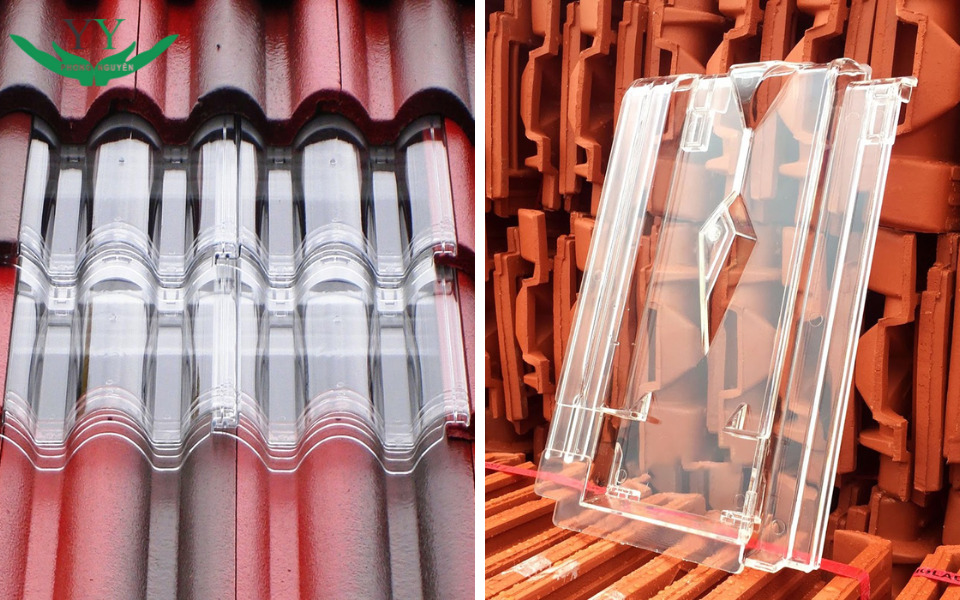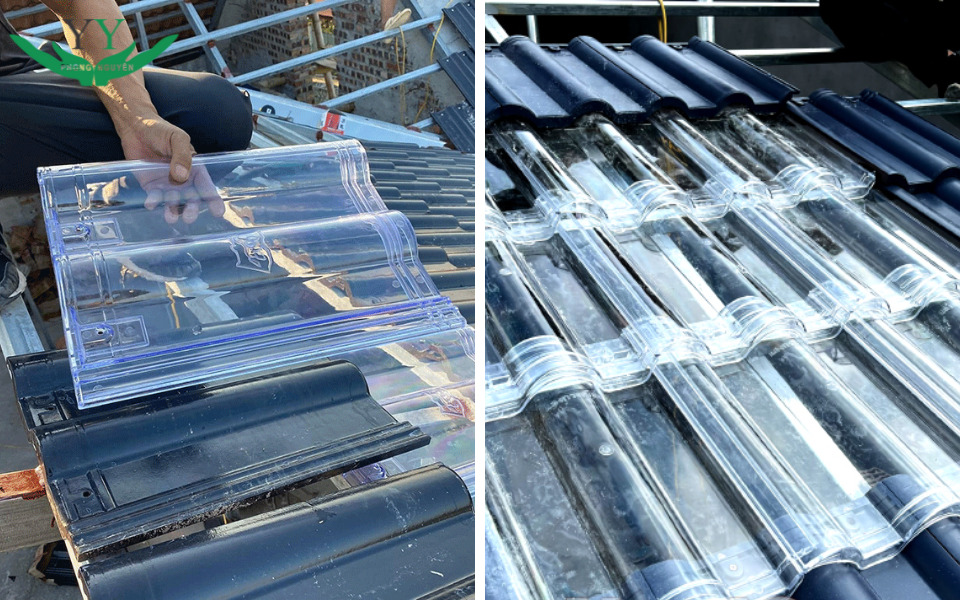Translucent plastic roof tile is a modern construction solution that utilizes natural light to reduce electricity costs. So, what exactly is translucent plastic roof tile? What advantages does it have compared to traditional materials? Let’s explore the details with Phong Nguyen in this article!
What is Translucent Plastic Roof Tile?
Translucent plastic roof tile is a type of roofing material made from synthetic plastic that allows light to pass through, effectively utilizing natural light to illuminate the space below.

This type of tile combines the protective features of traditional roofing materials with transparency, enabling sunlight to pass through. As a result, it has become a perfect solution for structures that require natural light, such as warehouses, commercial buildings, and residential homes.
Structure of Translucent Plastic Roof Tile
Translucent plastic roof tile are primarily made from synthetic polymer materials, with the most common types being:
- Polycarbonate (PC): The highest-quality material, known for its high mechanical strength, heat resistance, and excellent transparency.
- Polyvinyl Chloride (PVC): More affordable than PC, fire-resistant, but has lower durability and lifespan.
- Fiberglass Reinforced Plastic (FRP): A combination of fiberglass and plastic, offering high strength and UV resistance.
- Acrylic: Provides the highest transparency, but has lower impact resistance and heat tolerance than PC.
Typical Layered Structure of Translucent plastic roof tile
- Surface Layer: Coated with an anti-UV layer to prevent yellowing and brittleness over time.
- Middle Layer: Made of synthetic plastic, enhancing durability, impact resistance, and thermal insulation.
- Bottom Layer: Provides structural support, improves weather resistance, and minimizes damage from impact.
Types of Translucent Plastic Roof Tile
In Vietnam, translucent plastic roof tiles are categorized based on different criteria:
Classification by Material
The material used determines the durability, light transmission, and weather resistance of the tile. The most common materials include:
- Polycarbonate translucent plastic roof tile: High mechanical strength, excellent impact resistance, and superior transparency. These tiles are weather-resistant and commonly used for residential homes, public facilities, and skylights.
- PVC translucent plastic roof tile: Medium light transmission, more affordable than PC, lightweight, easy to install, and resistant to chemical corrosion, making them ideal for industrial buildings.
- FRP translucent plastic roof tile: Made from composite material combining fiberglass and polyester or vinyl ester resins. These tiles offer high strength, lightweight properties, and resistance to chemical corrosion, though they are more expensive than PC and PVC tiles.
Classification by Shape
- Corrugated Plastic Tile: Commonly used for houses, villas, and aesthetic-focused projects. The wavy design enhances natural beauty and water drainage.
- Flat Sheet Plastic Tile: Suitable for greenhouses, parking lot roofs, garden canopies, and public buildings. The flat design maximizes light transmission and creates a spacious environment.

Classification by Structure
- Solid Plastic Tile: A single-layered structure without internal gaps, offering high durability and impact resistance, making them ideal for residential and commercial projects.
- Hollow Plastic Tile (Honeycomb Design): Internal honeycomb chambers reduce weight and enhance thermal insulation. These tiles are ideal for areas requiring heat reduction, such as patio covers.
Advantages and Disadvantages of Translucent Plastic Roof Tile
Translucent plastic roof tiles are one of the modern building materials widely used in both residential and industrial projects due to their outstanding benefits. However, they also have certain limitations that you should be aware of before deciding to use them.
Advantages
- Excellent Light Transmission & Energy Savings: Translucent plastic roof tiles allow sunlight to penetrate, reducing reliance on artificial lighting and lowering electricity costs.
- Lightweight & Easy Installation: Compared to traditional materials like clay or concrete tiles, plastic tiles are significantly lighter, reducing the structural load on buildings and making transportation and installation easier.
- UV Protection: High-quality translucent plastic roof tiles are coated with UV-resistant layers, protecting occupants from harmful UV rays, making them ideal for skylights and greenhouses.
- Waterproof & Corrosion-Resistant: These tiles do not absorb water, preventing leakage and mold growth. Their plastic composition makes them resistant to rust and decay, unlike metal or wood materials.
- High Durability & Weather Resistance: Made from Polycarbonate, PVC, or composite materials, translucent plastic roof tiles can withstand impact, harsh weather conditions, and prolonged exposure to sunlight.
- Variety of Colors & Designs: Available in multiple colors, from transparent and milky white to blue, green, and brown, allowing for aesthetic customization.

Disadvantages
- Thermal Expansion Issues: Plastic tiles expand and contract with temperature fluctuations. Incorrect installation can lead to warping or gaps, affecting durability and waterproofing.
- Yellowing Over Time: Lower-quality tiles may turn yellow and become brittle after prolonged exposure to sunlight, reducing their transparency.
- Lower Thermal Insulation Compared to Traditional Tiles: While they allow sunlight in, some plastic tiles absorb heat, making interiors warmer—especially in hot climates.
Applications of Translucent Plastic Roof Tile
Warehouse
In factories and workshops, translucent plastic roof tiles are installed alternately with metal sheets or other roofing materials to maximize natural light. This significantly reduces daytime lighting costs and optimizes work efficiency. Additionally, with high durability and chemical resistance, these tiles are also ideal for warehouses, production areas, and livestock farms.
Public Facilities
Public structures such as bus stations, waiting areas, train stations, playgrounds, and outdoor sports arenas often use translucent plastic roof tiles to create open spaces and save energy. These tiles not only provide natural lighting but also help lower temperatures and mitigate the greenhouse effect.
Residential Architecture
Translucent plastic roof tiles are commonly used for house canopies, skylights, balconies, and rooftops. With excellent light transmission, they keep indoor spaces bright and airy while reducing dependence on electric lighting during the day. Moreover, tiles with UV-resistant coatings help protect residents’ health by minimizing the harmful effects of sunlight.

Commercial Buildings
Shopping centers, restaurants, cafés, and hotels often use translucent plastic roof tiles for outdoor dining areas, patios, or skylights to create open, well-lit, and nature-friendly spaces. Additionally, using these tiles helps save on daytime lighting costs, contributing to reduced operational expenses for businesses.

